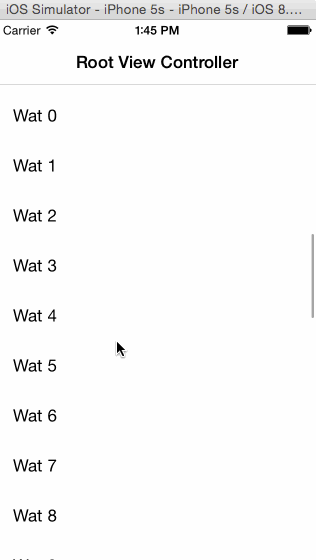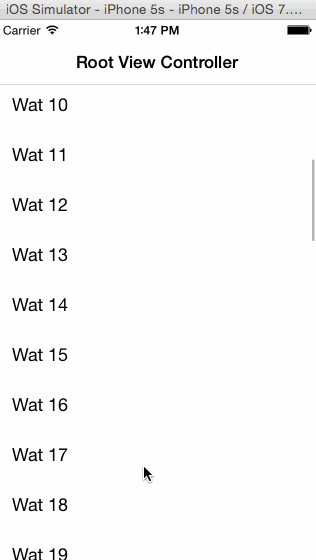Sto lavorando a un progetto che sia iOS7 e iOS8. E mi sono imbattuto in questo bug su iOS8, in cui il tableview "salta" quando si seleziona un oggetto.Errore UITableView in iOS8 quando si selezionano elementi con stimaHeight diverso da rowHeight
Questo errore è presente solo quando è impostata l'altezza stimata e differisce dall'altezza della riga.
Ecco due gif dello stesso codice in iOS8 e iOS7. Prima iOS 8:

E ora in iOS7:

ho fatto un progetto di esempio che mostra il bug qui: https://github.com/bjarkehs/TableViewiOS8Bug
Non sono sicuro se sono semplicemente manca qualcosa, ma sono bloccato con questo problema e non sono stato in grado di trovare nulla su questo.
Qui sono i miei metodi tableView:
- (NSInteger)numberOfSectionsInTableView:(UITableView *)tableView
{
return 3;
}
- (NSInteger)tableView:(UITableView *)tableView numberOfRowsInSection:(NSInteger)section
{
if (section == 1) {
return 30;
}
return 20;
}
- (UITableViewCell *)tableView:(UITableView *)tableView cellForRowAtIndexPath:(NSIndexPath *)indexPath
{
UITableViewCell *cell = [tableView dequeueReusableCellWithIdentifier:@"cell"];
if (cell == nil) {
cell = [[UITableViewCell alloc] initWithStyle:UITableViewCellStyleDefault reuseIdentifier:@"cell"];
}
cell.textLabel.text = [NSString stringWithFormat:@"%@ %ld", @"Wat", indexPath.row];
return cell;
}
- (CGFloat)tableView:(UITableView *)tableView estimatedHeightForRowAtIndexPath:(NSIndexPath *)indexPath
{
return 45.f;
}
- (CGFloat)tableView:(UITableView *)tableView heightForRowAtIndexPath:(NSIndexPath *)indexPath
{
return 50.f;
}
- (void)tableView:(UITableView *)tableView didSelectRowAtIndexPath:(NSIndexPath *)indexPath
{
[self.navigationController pushViewController:[UIViewController new] animated:YES];
}
Ecco un esempio viewcontroller dove l'altezza calcolata non è codificato, che mostra lo stesso problema:
#import "ViewController.h"
@interface ViewController()
@property (weak, nonatomic) IBOutlet UITableView *tableView;
@end
@implementation ViewController {
NSMutableArray *_items;
CGFloat _estimatedHeight;
}
- (void)viewDidLoad {
[super viewDidLoad];
self.tableView.delegate = self;
self.tableView.dataSource = self;
_estimatedHeight = 70.f;
CGFloat randomOffset = 30.f;
_items = [NSMutableArray new];
for (NSInteger i = 0; i < 3; i++) {
NSMutableArray *tempItems = [NSMutableArray new];
for (NSInteger j = 0; j < 30; j++) {
NSInteger offset = arc4random_uniform(randomOffset);
[tempItems addObject:@(_estimatedHeight + (randomOffset/2) - offset)];
}
[_items addObject:tempItems];
}
// Do any additional setup after loading the view.
}
- (NSInteger)numberOfSectionsInTableView:(UITableView *)tableView
{
return 3;
}
- (NSInteger)tableView:(UITableView *)tableView numberOfRowsInSection:(NSInteger)section
{
if (section == 1) {
return 30;
}
return 20;
}
- (UITableViewCell *)tableView:(UITableView *)tableView cellForRowAtIndexPath:(NSIndexPath *)indexPath
{
UITableViewCell *cell = [tableView dequeueReusableCellWithIdentifier:@"cell"];
if (cell == nil) {
cell = [[UITableViewCell alloc] initWithStyle:UITableViewCellStyleDefault reuseIdentifier:@"cell"];
}
cell.textLabel.text = [NSString stringWithFormat:@"%@ %ld", @"Wat", indexPath.row];
return cell;
}
- (CGFloat)tableView:(UITableView *)tableView estimatedHeightForRowAtIndexPath:(NSIndexPath *)indexPath
{
return _estimatedHeight;
}
- (CGFloat)tableView:(UITableView *)tableView heightForRowAtIndexPath:(NSIndexPath *)indexPath
{
return [[[_items objectAtIndex:indexPath.section] objectAtIndex:indexPath.row] floatValue];
}
- (void)tableView:(UITableView *)tableView didSelectRowAtIndexPath:(NSIndexPath *)indexPath
{
[self.navigationController pushViewController:[UIViewController new] animated:YES];
}
@end
Potrebbe essere necessario inviare i vostri metodi Tableview qui. – latenitecoder
Sì, potrei pure. I metodi tableview ci sono ora. –
Forse sono ritardato ma non riesco a vedere alcuna differenza tra 7 e 8. Qual è il problema esatto? –